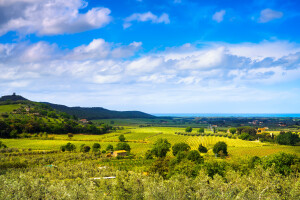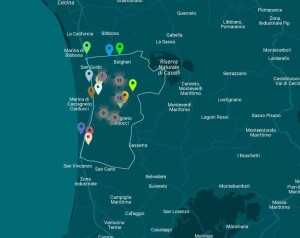The Bolgheri DOC—along with its famous sidekick the Bolgheri Sassicaia DOC—is famous for bold, red wines with the finest “Super Tuscan” pedigree. As such, I was fascinated to learn that when the Bolgheri DOC was first established—in 1983—the appellation was approved for white wines and rosé only, reflecting the traditional production of this region along the Tuscan coast.
Later—in the 1990s—the appellation rules were revised, allowing for the production of red wines based on the range of typical Tuscan red grapes (Sangiovese and friends). Even still, it wasn’t until the 2011 set of appellation updates that red wines based on including Cabernet Sauvignon, Merlot, and Cabernet Franc were allowed to be produced under the Bolgheri DOC.
Which brings us back to today’s news, which deals with a revision in the production standards for white wines—Bolgheri Bianco DOC—produced in the famous appellation. This was announced on December 1 (2021) when the news of the changes to the Disciplinare di Produzione for the Bolgheri DOC were published in the Gazzetta Ufficiale della Repubblica Italiana.
- According to the new standards, Bolgheri Bianco DOC may be produced using the following formulas:
- Any blend or amount of Vermentino, Sauvignon Blanc, and/or Viognier
- A maximum of 40% “other white grapes suitable for cultivation in Tuscany”
- (Trebbiano Toscano is known to be planted in small amounts in the region.)
- Varietally-labeled white wines may continue to be produced using (a minimum of 85%) Vermentino or Sauvignon Blanc.
Previously, Bolgheri Bianco was required to be produced using a matrix of prescribed “maximum amounts” of certain grapes (including 70% Vermentino (max), 40% Sauvignon Blanc (max), 40% Trebbiano Toscano (max) and 30% other white grapes (max).
According to statistics available on the website of the Consortium (Consorzio di Tutela Bolgheri e Bolgheri Sassicaia), about 11% of the appellation’s total 1,370 hectares (3,385 acres) of grapes are planted to white varieties. Of the white grapes, Vermentino—occupying about 120 hectares (297 acres)—is by far the most widely planted. Sauvignon Blanc comes in second with about 20 hectares (50 acres), followed by 8 hectares (20 acres) of Viognier. Other white grapes are present as well, in trace amounts.
For comparison’s sake, the most widely planted grape in the appellation is Cabernet Sauvignon, clocking in at a total of 502 hectares/ acres.
In other Bolgheri news: Included in the updates is a new regulation that requires any wine bottled under the Bolgheri DOC or Bolgheri Sassicaia DOC to include the term “Toscana” on the label above the term Bolgheri. This seems like a good marketing move.
References/for more information:
Post authored by Jane A. Nickles…your blog administrator: jnickles@societyofwineeducators.org

